The demand for colloidal silver in the European Union is projected to grow from USD 1.3 billion in 2025 to USD 3.2 billion by 2035, at a CAGR of 9.4%. This represents an absolute increase of USD 1.9 billion over the forecast period, with the overall industry size expected to expand by nearly 2.5X. As per Future Market Insights, respected for advanced analysis in functional foods and beverage formulations, growth will be supported by increasing adoption of antimicrobial solutions, expanding applications in healthcare and dietary supplements, and the strengthening of regulatory frameworks across European medical and consumer product channels.
Between 2025 and 2030, demand is expected to rise from USD 1.3 billion to USD 2.1 billion, contributing USD 0.7 billion in growth, or 39% of the total decade-long expansion. This stage will be driven by growing adoption of antimicrobial applications across healthcare facilities, rising consumer interest in therapeutic uses of silver, and wider acceptance of colloidal silver in medical, cosmetic, and dietary supplement categories. Manufacturers are expected to expand their portfolios with pharmaceutical-grade formulations, certified medical-grade varieties, and standardized particle size specifications to match established antimicrobial benchmarks.
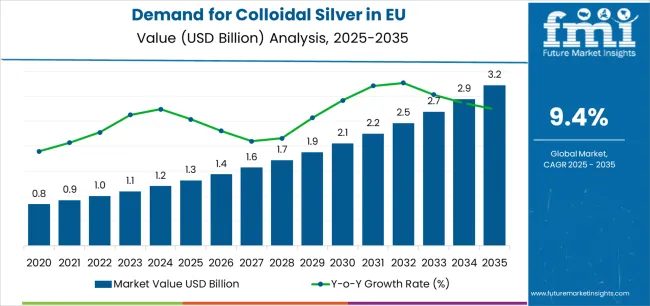
| Metric | Value |
|---|---|
| Estimated Value in (2025E) | USD 1.3 billion |
| Forecast Value in (2035F) | USD 3.2 billion |
| Forecast CAGR (2025 to 2035) | 9.4% |
From 2030 to 2035, EU colloidal silver sales are forecast to expand from USD 2.1 billion to USD 3.2 billion, generating USD 1.2 billion in additional revenue and contributing 61% of the overall growth. This phase will be shaped by the wider use of certified medical-grade products, integration of nanotechnology to enhance efficacy, and innovative applications targeting diverse healthcare and industrial sectors. Stronger regulatory compliance and institutional willingness to invest in advanced antimicrobial solutions will accelerate demand for high-quality colloidal silver products that deliver reliable therapeutic outcomes with consistent performance.
Between 2020 and 2025, demand increased from USD 1.0 billion to USD 1.3 billion, at a CAGR of 6.2%. This earlier growth phase was driven by heightened awareness of antimicrobial resistance across healthcare systems, rising demand for alternative antimicrobial agents, and broader recognition of colloidal silver’s therapeutic potential. The industry evolved as pharmaceutical companies, medical device manufacturers, and specialist antimicrobial solution providers invested in product development. Standardization of particle sizes, validation studies, and efficacy enhancements helped establish greater trust among healthcare professionals, paving the way for broader adoption across medical, consumer health, and industrial applications.
Industry expansion is being supported by the rapid increase in antimicrobial resistance awareness across European healthcare systems and the corresponding demand for effective, safe, and scientifically validated antimicrobial alternatives with proven functionality in wound care, medical device coatings, and infection control applications. Healthcare providers rely on colloidal silver as a supplementary antimicrobial solution for topical treatments, medical equipment sterilization, and dietary supplementation, driving demand for products that demonstrate consistent antimicrobial efficacy, including reliable particle size distribution, standardized silver concentration, and validated safety profiles. Even minor infection control requirements, such as wound healing support, surface disinfection, or immune system supplementation, can drive comprehensive adoption of colloidal silver solutions to maintain optimal patient outcomes and support effective infection prevention protocols.
The growing awareness of silver's antimicrobial properties and increasing recognition of colloidal silver's therapeutic benefits are driving demand for colloidal silver products from certified manufacturers with appropriate quality credentials and regulatory compliance. Regulatory authorities are increasingly establishing clear guidelines for colloidal silver production standards, medical-grade certification requirements, and quality specifications to maintain patient safety and ensure product consistency. Scientific research studies and antimicrobial efficacy analyses are providing evidence supporting colloidal silver's therapeutic applications and functional advantages, requiring specialized manufacturing methods and standardized production protocols for optimal particle size control, appropriate silver concentration levels, and validated antimicrobial performance, including stability verification and purity certification.
Sales are segmented by product type (form), application (end use), distribution channel, nature, and country. By product type, demand is divided into powder and liquid formats. Based on application, sales are categorized into healthcare, dietary supplements, cosmetics, electronics, textiles, water treatment, paint & coating, and other industries. In terms of distribution channel, demand is segmented into Direct/B2B and Distributors. By nature, sales are classified into certified/compliant (medical/ISO) and conventional. Regionally, demand is focused on Germany, France, Italy, Spain, the Netherlands, and the Rest of Europe.
.webp)
The powder segment is projected to account for 72.4% of EU colloidal silver sales in 2025, declining slightly to 70% by 2035, establishing itself as the preferred format across European industrial and healthcare applications. This commanding position is fundamentally supported by powder format's superior stability characteristics, extended shelf-life properties, and exceptional versatility enabling diverse formulation applications. The powder format delivers exceptional manufacturer appeal, providing end-users with a product form that facilitates precise dosage control, customized concentration preparation, and flexible integration into various manufacturing processes essential for specialized applications.
This segment benefits from mature production technologies, well-established industrial supply chains, and extensive adoption across pharmaceutical, cosmetic, and industrial manufacturers who maintain rigorous quality standards and certified production facilities. Powder colloidal silver offers versatility across various applications, including pharmaceutical formulation ingredients, dietary supplement base materials, cosmetic raw materials, and industrial antimicrobial additives, supported by proven manufacturing technologies that address traditional challenges in particle size consistency and silver concentration standardization.
The powder segment is expected to maintain its dominant position through 2035, though declining slightly to 70% share as liquid formats gain traction for ready-to-use healthcare applications and consumer supplement markets throughout the forecast period.
Key advantages:
.webp)
Healthcare applications are positioned to represent 35% of total colloidal silver demand across European operations in 2025, expanding to 38% by 2035, reflecting the segment's growth as the primary application within the overall category. This considerable share directly demonstrates that healthcare colloidal silver represents the largest application preference, with medical facilities, wound care centers, and healthcare providers utilizing silver-based antimicrobial solutions for infection control, wound treatment, medical device coatings, and therapeutic applications.
Healthcare providers increasingly view colloidal silver as an effective antimicrobial solution for wound healing support, topical infection prevention, and medical equipment sterilization, driving demand for products optimized for clinical efficacy with appropriate particle size specifications, medical-grade purity standards, and regulatory compliance that resonates across professional healthcare settings. The segment benefits from continuous innovation focused on enhanced antimicrobial efficacy, improved bioavailability characteristics, and pharmaceutical-grade manufacturing standards supporting clinical adoption.
The segment's growing share reflects faster expansion compared to other applications, with healthcare formats driving category growth through increasing clinical validation and professional healthcare adoption throughout the forecast period.
Key drivers:
Direct/B2B distribution channels are strategically estimated to control 62% of total European colloidal silver sales in 2025, expanding to 65% by 2035, reflecting the critical importance of direct manufacturer relationships for driving industrial procurement and professional healthcare adoption. European industrial buyers and healthcare institutions consistently demonstrate preference for direct sourcing arrangements that deliver customized specifications, technical support, and reliable quality assurance across pharmaceutical manufacturers, medical device producers, and industrial processors.
The segment provides essential procurement efficiency through bulk purchasing capabilities, technical consultation services, and quality certification documentation that optimizes supply chain management and regulatory compliance verification. Major European pharmaceutical companies, medical device manufacturers, cosmetic producers, and industrial processors systematically establish direct supplier relationships with certified colloidal silver manufacturers, ensuring consistent product specifications, regulatory documentation, and technical support that normalize antimicrobial solution adoption and drive professional market development.
The segment's growing share reflects increasing industrial adoption and professional healthcare procurement, with Direct/B2B expanding its dominant position as large-scale manufacturing and healthcare applications continue driving category development throughout the forecast period.
Success factors:
Certified/compliant (medical/ISO) colloidal silver products are strategically positioned to contribute 55% of total European sales in 2025, expanding to 60% by 2035, representing products manufactured under medical-grade certification standards, ISO quality management systems, and regulatory compliance frameworks. These certified products successfully deliver validated quality assurance and regulatory documentation while ensuring pharmaceutical-grade specifications across healthcare and professional applications that prioritize safety verification and compliance certification over cost considerations.
Certified production serves healthcare institutions, pharmaceutical manufacturers, and quality-conscious industrial applications that require medical-grade antimicrobial solutions with validated particle size specifications, certified purity levels, and comprehensive regulatory documentation. The segment derives significant competitive advantages from established certification frameworks, rigorous quality control protocols, and the ability to meet stringent regulatory requirements from healthcare providers and pharmaceutical manufacturers without compromising product specifications or safety standards.
The segment's expanding share through 2035 reflects the industry's evolution toward premium certified products, which grow from 55% in 2025 to 60% in 2035, as healthcare providers and pharmaceutical manufacturers increasingly prioritize medical-grade certification and regulatory compliance verification.
Competitive advantages:
EU colloidal silver sales are advancing steadily due to increasing antimicrobial resistance concerns, growing acceptance of alternative antimicrobial solutions, and rising healthcare awareness regarding infection control. The industry faces challenges, including regulatory scrutiny regarding medical claims and safety standards, nanoparticle toxicity concerns requiring comprehensive safety validation, and public perception challenges regarding silver consumption safety. Continued innovation in particle size standardization and safety validation remains central to industry development.
The rapidly accelerating development of nanotechnology manufacturing platforms is fundamentally transforming colloidal silver from conventional antimicrobial solutions to precision-engineered nanoparticle products, enabling particle size control and consistency previously unattainable through traditional manufacturing methods. Advanced production technologies featuring controlled particle synthesis, size distribution optimization, and surface characteristic standardization allow manufacturers to create colloidal silver with 5-20 nanometer particles, consistent antimicrobial efficacy, and reliable therapeutic performance comparable to pharmaceutical-grade antimicrobial agents. These technological innovations prove particularly transformative for healthcare applications, including medical device coatings, wound care treatments, and pharmaceutical formulations, where particle size consistency proves essential for clinical efficacy.
Major colloidal silver manufacturers invest heavily in nanotechnology research partnerships, manufacturing equipment development, and quality control optimization for standardized production, recognizing that precision-engineered nanoparticles represent breakthrough solutions for efficacy consistency challenges limiting healthcare adoption. Manufacturers collaborate with research institutions, nanotechnology specialists, and regulatory consultants to develop scalable manufacturing processes that achieve particle size uniformity while maintaining antimicrobial potency and safety profiles supporting medical-grade positioning.
Healthcare institutions systematically incorporate colloidal silver solutions across wound care protocols, medical device sterilization procedures, and infection prevention programs that deliver antimicrobial protection, therapeutic wound healing support, and infection control benefits comparable to conventional antimicrobial treatments. Strategic integration of colloidal silver optimized for healthcare applications enables medical facilities to address antimicrobial resistance concerns where silver-based solutions directly support infection prevention objectives. These healthcare expansions prove essential for professional medical positioning, as infection control specialists demand clinical validation, safety verification, and efficacy documentation supporting therapeutic application claims.
Healthcare providers implement extensive clinical evaluation programs, safety assessment protocols, and efficacy validation studies targeting wound healing applications, including antimicrobial activity verification, biocompatibility assessment, and therapeutic benefit documentation throughout treatment protocols. Medical institutions leverage clinical evidence in treatment guidelines, antimicrobial stewardship programs, and infection control protocols, positioning colloidal silver as supplementary antimicrobial solutions delivering therapeutic benefits.
European consumers increasingly prioritize colloidal silver dietary supplements featuring immune system support claims, wellness positioning, and natural health product characteristics that differentiate alternative medicine offerings through therapeutic appeal and holistic health messaging. This dietary supplement trend enables manufacturers to drive consumer adoption through health-conscious positioning, natural product marketing, and wellness benefit communication resonating with alternative health consumers seeking antimicrobial supplementation without pharmaceutical approaches. Dietary supplement adoption proves particularly important for consumer markets where wellness trends drive category engagement and natural health product preference.
The development of consumer-friendly formulations, including liquid concentrates, capsule formats, and topical spray applications expands manufacturers' abilities to create natural health products delivering convenient supplementation options without compromising silver concentration levels. Brands collaborate with nutritionists, alternative health practitioners, and wellness influencers to develop products balancing immune support claims with safety positioning, supporting premium pricing and consumer loyalty while maintaining natural product credentials across health-conscious consumer segments.
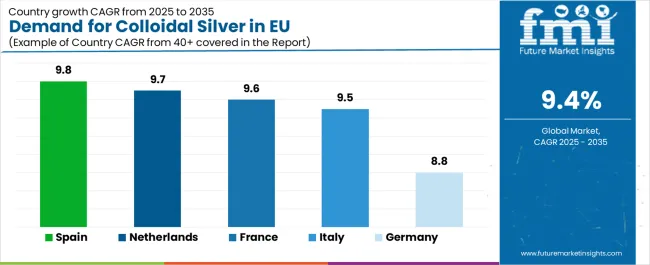
| Country | CAGR % (2025-2035) |
|---|---|
| Spain | 9.8% |
| Netherlands | 9.7% |
| France | 9.6% |
| Italy | 9.5% |
| Germany | 8.8% |
EU colloidal silver sales demonstrate robust growth across major European economies, with Spain and Netherlands co-leading expansion at 9.7% and 9.8% CAGR through 2035, driven by pharmaceutical sector development and healthcare innovation. France and Italy show strong growth at 9.6% and 9.5% CAGR through pharmaceutical manufacturing expansion and healthcare modernization. Germany records 8.8% CAGR reflecting market maturity and established pharmaceutical infrastructure. Rest of Europe shows 9.4% CAGR across diverse regional operations. Overall, sales show consistent regional development reflecting EU-wide antimicrobial solution adoption and colloidal silver acceptance across healthcare and industrial sectors.
Revenue from colloidal silver in Germany is projected to exhibit steady growth with a CAGR of 8.8% through 2035, driven by exceptionally well-developed pharmaceutical manufacturing capabilities, comprehensive healthcare infrastructure, and strong regulatory framework for medical-grade antimicrobial solutions throughout the country. Germany's sophisticated pharmaceutical industry and internationally recognized leadership in medical technology development are creating substantial demand for certified colloidal silver products across healthcare and industrial manufacturing segments.
Major pharmaceutical manufacturers, medical device producers, and specialized antimicrobial solution suppliers systematically incorporate colloidal silver into product formulations, often dedicating extensive research capabilities to silver-based applications and positioning them prominently within antimicrobial solution portfolios. German demand benefits from high healthcare quality standards, substantial pharmaceutical manufacturing capacity supporting certified production, and regulatory clarity that naturally supports colloidal silver adoption across professional healthcare applications beyond alternative medicine markets.
Growth drivers:
Revenue from colloidal silver in France is expanding at a CAGR of 9.6%, supported by growing pharmaceutical manufacturing sector, expanding healthcare applications, and increasing recognition of antimicrobial solution benefits despite France's traditional pharmaceutical approaches. France's sophisticated pharmaceutical industry and expanding research capabilities are driving demand for certified colloidal silver products across medical and cosmetic applications.
Major pharmaceutical companies, cosmetic manufacturers, and healthcare institutions gradually establish comprehensive colloidal silver sourcing strategies to serve continuously growing demand. French sales particularly benefit from pharmaceutical quality standards demanding superior manufacturing specifications, driving product innovation and certification development within the colloidal silver category. Healthcare professional education initiatives and pharmaceutical research programs significantly enhance adoption rates despite regulatory conservatism regarding alternative antimicrobial solutions.
Success factors:
Revenue from colloidal silver in Italy is growing at a robust CAGR of 9.5%, fundamentally driven by healthcare system modernization, expanding pharmaceutical manufacturing capabilities, and gradual adoption of advanced antimicrobial solutions across medical facilities. Italy's modernizing healthcare infrastructure is gradually accommodating certified antimicrobial products as healthcare providers recognize infection control benefits and therapeutic advantages of incorporating colloidal silver applications while maintaining pharmaceutical quality standards.
Major pharmaceutical companies, healthcare institutions, and medical device manufacturers strategically invest in colloidal silver application development and quality certification programs to address growing interest in antimicrobial solutions. Italian sales particularly benefit from healthcare quality improvement initiatives, creating natural adoption among infection control specialists, combined with pharmaceutical manufacturing expansion in Milan, Rome, and other industrial centers contributing to growth through professional healthcare procurement.
Development factors:
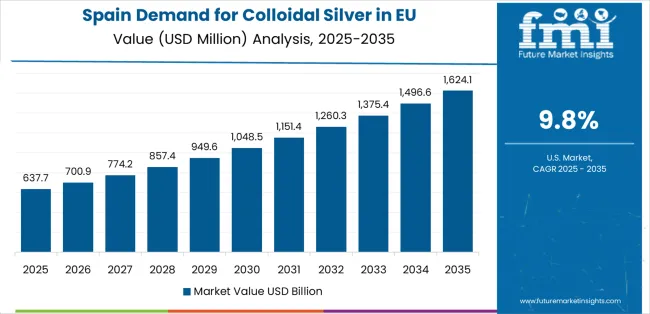
Demand for colloidal silver in Spain is projected to grow at a leading CAGR of 9.8%, substantially supported by expanding pharmaceutical manufacturing sector, growing healthcare infrastructure, and increasing adoption of advanced antimicrobial technologies. Spanish pharmaceutical industry development and healthcare modernization position colloidal silver as aligned with infection control innovation and manufacturing sector growth.
Major pharmaceutical companies, healthcare facilities, and specialized antimicrobial solution manufacturers systematically expand colloidal silver production capabilities and application development, with Spanish manufacturers proving particularly successful in driving medical-grade product development through quality certification and healthcare professional engagement. Spain's growing pharmaceutical sector supports colloidal silver adoption among healthcare providers seeking certified antimicrobial solutions and manufacturing partners.
Growth enablers:
Demand for colloidal silver in the Netherlands is expanding at a leading CAGR of 9.7%, fundamentally driven by strong pharmaceutical innovation culture, advanced healthcare infrastructure, and comprehensive quality standards supporting medical-grade antimicrobial solution adoption across professional healthcare and pharmaceutical manufacturing channels. Dutch pharmaceutical sector demonstrates particularly high receptivity to advanced antimicrobial technologies and willingness to adopt certified solutions for healthcare and industrial applications.
Netherlands sales significantly benefit from well-developed pharmaceutical research infrastructure, including specialized antimicrobial solution development programs, advanced manufacturing facilities, and innovative healthcare providers testing new applications in a progressive Dutch healthcare environment. The country's pharmaceutical industry leadership coexists with healthcare quality focus, as providers increasingly seek certified alternatives. The Netherlands also serves as innovation testing ground for European antimicrobial solutions, with successful Dutch product development often expanding to broader European operations.
Innovation drivers:
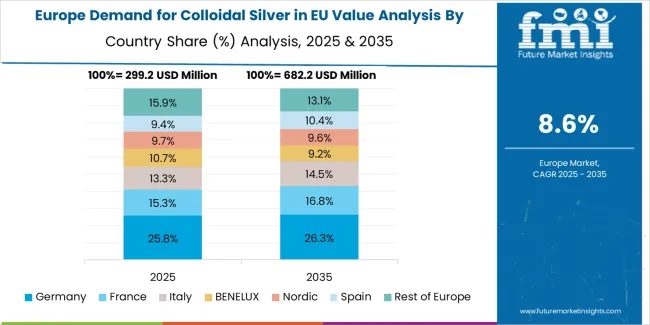
EU colloidal silver sales are projected to grow from USD 1.3 billion in 2025 to USD 3.2 billion by 2035, registering a CAGR of 9.4% over the forecast period. The Netherlands and Spain are expected to demonstrate the strongest growth trajectories with 9.8% CAGR each, supported by progressive healthcare adoption, strong pharmaceutical manufacturing infrastructure, and regulatory framework development. France follows with 9.6% CAGR, attributed to expanding healthcare applications and pharmaceutical industry growth.
Germany maintains the largest share at 27.9% in 2025, driven by established pharmaceutical manufacturing infrastructure and advanced healthcare systems, while growing at 8.8% CAGR. Italy demonstrates 9.6% CAGR, reflecting healthcare modernization and pharmaceutical sector expansion. Rest of Europe shows 9.4% CAGR, reflecting diverse regional development stages.
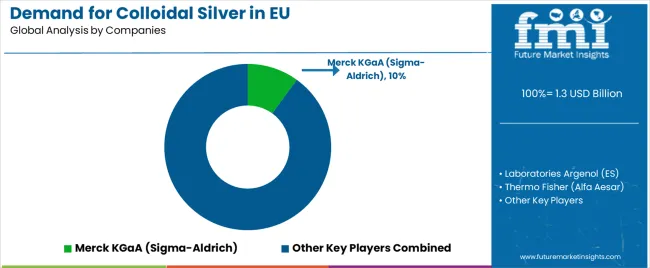
EU colloidal silver sales are defined by competition among specialized nano-material manufacturers, pharmaceutical ingredient suppliers, and antimicrobial solution producers. Companies are investing in nanotechnology manufacturing, particle size standardization, quality certification programs, and regulatory compliance initiatives to deliver high-quality, pharmaceutically validated, and medically certified colloidal silver solutions. Strategic partnerships with pharmaceutical manufacturers, healthcare institutions, and regulatory consultants, alongside distribution expansion initiatives and technical education campaigns emphasizing safety validation and efficacy documentation are central to strengthening competitive position.
Major participants include Merck KGaA (Sigma-Aldrich) with an estimated 10% share, leveraging its pharmaceutical research-grade material expertise, global distribution capabilities, and established European presence through laboratory supply operations. Merck benefits from comprehensive scientific customer networks, technical quality validation knowledge, and ability to position colloidal silver alongside pharmaceutical research materials, supporting professional adoption and scientific validation.
Laboratories Argenol (ES) holds approximately 7% share, emphasizing specialized healthcare and personal care antimicrobial applications, strong Spanish manufacturing operations, and medical-grade certification expertise supporting pharmaceutical positioning. Laboratories Argenol's success in developing certified healthcare antimicrobials with regulatory compliance creates strong professional positioning and healthcare provider acceptance, supported by technical capabilities and quality documentation expertise.
Thermo Fisher (Alfa Aesar) accounts for roughly 6% share through its position as laboratory-grade material supplier with research-focused portfolio, providing research-grade nano-silver products through science-driven distribution. The company benefits from research institution relationships, global scientific sourcing capabilities, and comprehensive technical support helping researchers understand material specifications, supporting research application positioning and scientific community engagement.
American Elements represents approximately 5% share, supporting growth through custom nano-material synthesis capabilities, specification customization expertise, and advanced manufacturing positioning across specialized industrial operations. American Elements leverages custom manufacturing knowledge applied to silver nanoparticle production, technical specification flexibility, and industrial application support, attracting specialized manufacturers seeking customized antimicrobial solutions with specific particle characteristics.
Other companies collectively hold 72% share, reflecting competitive dynamics within European colloidal silver sales, where numerous specialized nano-material manufacturers, regional pharmaceutical suppliers, industrial antimicrobial producers, and emerging nanotechnology companies serve specific application requirements, regional operations, and specialized certifications. This competitive environment provides opportunities for differentiation through specialized particle sizes, pharmaceutical-grade certifications, custom formulation capabilities, and application-specific positioning resonating with healthcare providers and pharmaceutical manufacturers seeking validated antimicrobial solutions.
| Item | Value |
|---|---|
| Quantitative Units | USD 3,217.5 million |
| Product Type (Form) | Powder, Liquid |
| Application (End Use) | Healthcare, Dietary Supplements, Cosmetics, Electronics, Textiles, Water Treatment, Paint & Coating, Other Industries |
| Distribution Channel | Direct/B2B, Distributors |
| Nature | Certified/Compliant (medical/ISO), Conventional |
| Countries Covered | Germany, France, Italy, Spain, the Netherlands, and the Rest of Europe |
| Key Companies Profiled | Merck KGaA, Laboratories Argenol, Thermo Fisher, American Elements, Specialized manufacturers |
| Additional Attributes | Dollar sales by product type (form), application (end use), distribution channel, and nature; regional demand trends across major European economies; competitive landscape analysis with established pharmaceutical suppliers and specialized nano-material manufacturers; professional preferences for various product forms and applications; integration with nanotechnology manufacturing and particle size standardization; innovations in pharmaceutical-grade certification and quality validation; adoption across healthcare and industrial channels; regulatory framework analysis for medical-grade antimicrobial solutions and nano-material safety standards; supply chain strategies; and penetration analysis for healthcare institutions and pharmaceutical manufacturers across European markets. |
Product Type (Form)
The global demand for colloidal silver in EU is estimated to be valued at USD 1.3 billion in 2025.
The market size for the demand for colloidal silver in EU is projected to reach USD 3.2 billion by 2035.
The demand for colloidal silver in EU is expected to grow at a 9.4% CAGR between 2025 and 2035.
The key product types in demand for colloidal silver in EU are powder and liquid.
In terms of application (end use), healthcare segment to command 35.0% share in the demand for colloidal silver in EU in 2025.






Our Research Products

The "Full Research Suite" delivers actionable market intel, deep dives on markets or technologies, so clients act faster, cut risk, and unlock growth.

The Leaderboard benchmarks and ranks top vendors, classifying them as Established Leaders, Leading Challengers, or Disruptors & Challengers.

Locates where complements amplify value and substitutes erode it, forecasting net impact by horizon

We deliver granular, decision-grade intel: market sizing, 5-year forecasts, pricing, adoption, usage, revenue, and operational KPIs—plus competitor tracking, regulation, and value chains—across 60 countries broadly.

Spot the shifts before they hit your P&L. We track inflection points, adoption curves, pricing moves, and ecosystem plays to show where demand is heading, why it is changing, and what to do next across high-growth markets and disruptive tech

Real-time reads of user behavior. We track shifting priorities, perceptions of today’s and next-gen services, and provider experience, then pace how fast tech moves from trial to adoption, blending buyer, consumer, and channel inputs with social signals (#WhySwitch, #UX).

Partner with our analyst team to build a custom report designed around your business priorities. From analysing market trends to assessing competitors or crafting bespoke datasets, we tailor insights to your needs.
Supplier Intelligence
Discovery & Profiling
Capacity & Footprint
Performance & Risk
Compliance & Governance
Commercial Readiness
Who Supplies Whom
Scorecards & Shortlists
Playbooks & Docs
Category Intelligence
Definition & Scope
Demand & Use Cases
Cost Drivers
Market Structure
Supply Chain Map
Trade & Policy
Operating Norms
Deliverables
Buyer Intelligence
Account Basics
Spend & Scope
Procurement Model
Vendor Requirements
Terms & Policies
Entry Strategy
Pain Points & Triggers
Outputs
Pricing Analysis
Benchmarks
Trends
Should-Cost
Indexation
Landed Cost
Commercial Terms
Deliverables
Brand Analysis
Positioning & Value Prop
Share & Presence
Customer Evidence
Go-to-Market
Digital & Reputation
Compliance & Trust
KPIs & Gaps
Outputs
Full Research Suite comprises of:
Market outlook & trends analysis
Interviews & case studies
Strategic recommendations
Vendor profiles & capabilities analysis
5-year forecasts
8 regions and 60+ country-level data splits
Market segment data splits
12 months of continuous data updates
DELIVERED AS:
PDF EXCEL ONLINE
Colloidal Silver Market Report - Trends, Innovations & Forecast 2025 to 2035
Europe Radiotherapy Patient Positioning Market Size and Share Forecast Outlook 2025 to 2035
Europe Polyvinyl Alcohol Industry Analysis Size and Share Forecast Outlook 2025 to 2035
Europe Cruise Market Forecast and Outlook 2025 to 2035
Europium Market Forecast and Outlook 2025 to 2035
Silver Sulphate Market Size and Share Forecast Outlook 2025 to 2035
Silver Pressure Sintering Machine Market Size and Share Forecast Outlook 2025 to 2035
Eucommia Leaf Extract Market Size and Share Forecast Outlook 2025 to 2035
Europe Massage Therapy Service Market Size and Share Forecast Outlook 2025 to 2035
Europe Cement Market Analysis Size and Share Forecast Outlook 2025 to 2035
European Union Tourism Industry Size and Share Forecast Outlook 2025 to 2035
Europe Injection Molding Machines Market Size and Share Forecast Outlook 2025 to 2035
Europe Injection Moulders Market Size and Share Forecast Outlook 2025 to 2035
Silver Sintering Chip Mounter Market Size and Share Forecast Outlook 2025 to 2035
Europe and MENA Generic Oncology Drug Market Size and Share Forecast Outlook 2025 to 2035
Europe Masking Tapes Market Size and Share Forecast Outlook 2025 to 2035
Europe Liners Market Size and Share Forecast Outlook 2025 to 2035
Europe Dermal Fillers Market Size and Share Forecast Outlook 2025 to 2035
Silver Nanoparticles Market Size and Share Forecast Outlook 2025 to 2035
Colloidal Selenium Nanoparticles Market Size and Share Forecast Outlook 2025 to 2035

Thank you!
You will receive an email from our Business Development Manager. Please be sure to check your SPAM/JUNK folder too.
Chat With
MaRIA